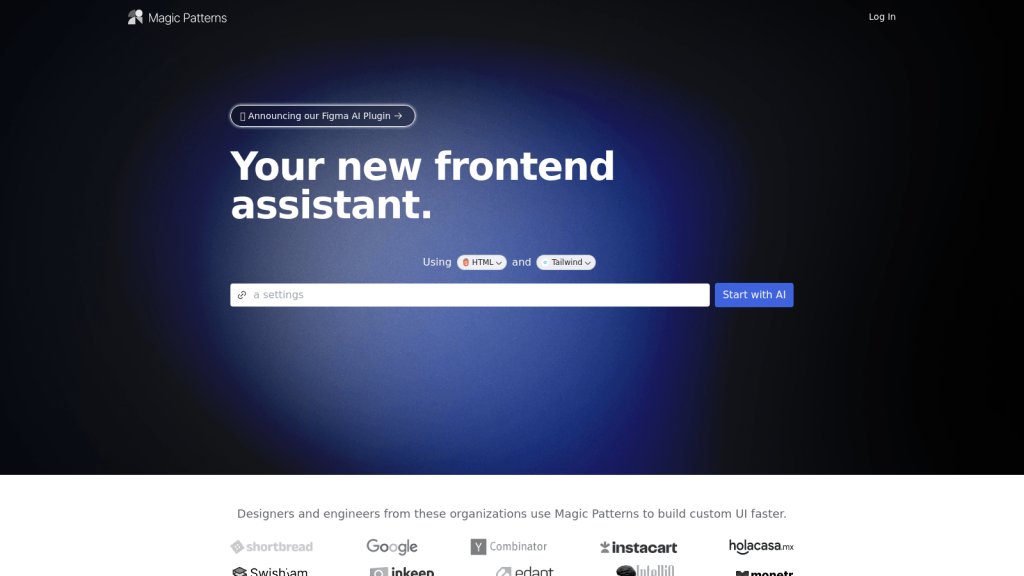What is Magic Patterns?
Magic Patterns is a game-changing tool that accelerates the process of front-end development through the conversion of Figma designs into clean and accurate HTML code. By harnessing the power of AI, it bridges the gap in custom UI component integrations from various design systems with unprecedented ease for both designers and developers.
Key Features & Benefits of Magic Patterns
Magic Patterns is more than just a feature; it’s a bundle of features empowering the design-to-code workflow, including:
-
AI-Powered Component Generation:
Figma designs magically turn into HTML code, saving a lot of your time spent coding by hand. -
Seamless Framework Integration:
It provides all-round support with UI frameworks such as Mantine, Chakra UI, Shadcn, Radix, and Tailwind. -
Custom Design Systems:
You can create your own UI components from virtually any design system. -
Patterns Showcase:
A library of creative patterns and components ready for immediate implementation in your projects.
Due to this fact, Magic Patterns come with a number of advantages: greatly improved efficiency, extended customization, and generally strong design-to-code for easier collaboration between designers and developers.
Use Cases of Magic Patterns and Where to Apply Them
The use cases of Magic Patterns are practically unlimited; however, their application will be most justified in the following contexts:
-
Rapid Prototyping:
Speeds up the process of prototyping by rapidly transforming Figma designs into functional HTML components. -
Smoothen Team Collaboration:
Bridges the gap between designers and developers with the translation of design language into developer-friendly code. -
Custom UI Development:
The possibility to develop unique UIs is opened, supporting custom design systems and multiple UI frameworks.
Companies operating in such vertical markets as web development, digital agencies, and software engineering stand to hugely benefit by integrating Magic Patterns into their workflow.
How to Use Magic Patterns
Using Magic Patterns is easy. Here’s how you can get started:
-
Import Your Design:
Just import your design from Figma into Magic Patterns. -
Set Up Settings:
Select your UI framework and choose any custom design systems you want to utilize. -
Generate Code:
Magic Patterns will use AI to convert your design into clean, readable HTML code. -
Implement Components:
Consume these generated components directly into your project.
For the best results, you should make sure that your design is well-structured in Figma and follows all the principles of design. In any case, it’s simple to find your way around and work with Magic Patterns, whether you’re a user getting familiar with UI design or an advanced user.
How Magic Patterns Works
Advanced AI algorithms constitute the core of Magic Patterns. They enable the analysis of a design in Figma and subsequent conversion to HTML code. To put that in more straightforward words, the process goes as follows:
-
Design Analysis:
The AI would go through the Figma design to understand its layout, from high-level components. -
Code Generation:
Upon design analysis, it generates clean and developer-friendly HTML code. -
Framework Integration:
Integrates generated code with a selected UI framework to make it compatible and easy to use.
This workflow will give you a frictionless transition from design to development with everything included according to your actual design with aesthetic value too.
Pros and Cons of Magic Patterns
Like any tool, Magic Patterns also has some pros and cons:
Pros:
- Saves time by generating code automatically.
- It supports multiple UI frameworks for flexibility.
- Improves collaboration between designers and developers.
- Offers personalization through custom design systems.
Cons:
- Sometimes complex designs may need fine-tuning.
- New users take a bit of time getting used to it.
User feedback typically mentions how much time it saves and improves workflow, though some mention that sometimes it needs a little tweak or two here and there.
Conclusion about Magic Patterns
In all, Magic Patterns is a powerful assistant that seriously livens up the process of front-end development by translating Figma designs into HTML code. Multiple UI framework support, together with customized design systems, makes it a really versatile solution to be applied in various industries. Though some learning curve might be expected, investing in Magic Patterns pays off highly because of increased efficiency and better collaboration.
As Magic Patterns continues to evolve, users can look forward to increasing features and enhancement that continue to smoothen the pipeline from design to code.
Magic Patterns FAQs
Q: What design tooling does Magic Patterns support?
A: Currently, Magic Patterns supports-primarily Figma designs into HTML code.
Q: Can I use Magic Patterns with my existing design system?
A: Yes, Magic Patterns enables you to make custom UI components from any design system, including your own.
Q: Is Magic Patterns good for beginners?
A: Though there is a curve in initial learning, it’s intuitive and hence can easily be used by beginners with little practice.










